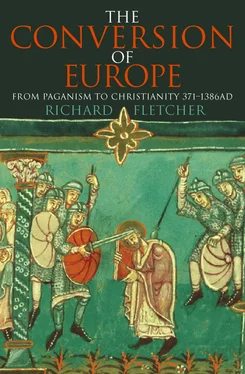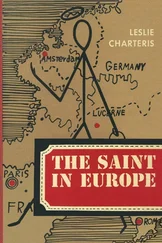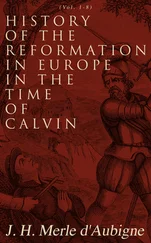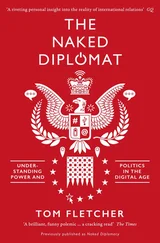It was not always so. Here is Bede on the (unnamed) wife of King Redwald of East Anglia.
Redwald had been initiated into the mysteries of the Christian faith in Kent, but in vain. For on his return home he was seduced by his wife and by certain evil teachers and perverted from the sincerity of his faith, so that his last state was worse than his first. After the manner of the ancient Samaritans, he seemed to be serving both Christ and the gods whom he had previously served; in the same temple he had one altar for the Christian sacrifice and another small altar on which to offer victims to devils.
It is an interesting story. Another way of interpreting it would be to see Redwald’s acceptance of Christianity simply as the addition of a new god to his pantheon of deities. It may well have been that the exclusive claims of the Christian God were ill-understood at first by royal converts.
Royal hesitation, thirdly, is a notable feature of our narratives. Clovis, Ethelbert and Edwin all took their time. Abandonment of the old gods was no light matter. Consultation with counsellors was prudent. How would the pagan priesthood react? Coifi is the classic case of the poacher turned gamekeeper. Redwald’s men seem to have been less pliable. There are difficult questions here about the dynamics of a king’s authority over his kinsfolk, his realm and his vassal kingdoms. It is hard to judge whether conversion came about through individual choice or through pressure exerted by the solidarity of a group. Arguments can be marshalled in support of both propositions. For example, the interesting information preserved by Bede that eleven members of the royal entourage were baptized with the infant Eanflaed in June 626 – ten months before Edwin’s baptism – might suggest that in Northumbria at least there was scope for individual choice. Doubtless the truth is that both individual and group motivation co-existed side by side; even, at different times, in the same person. We can be sure that a royal lead for others to follow was effective, even though the conversions it prompted may have been less than wholly sincere, as Bede was aware. We must note too that giving a lead did not always work even within the royal family. Ethelbert’s son Eadbald remained a pagan throughout his father’s life; the heathen Penda’s son Peada became a Christian.
Finally, we may observe the manner in which conversion was accompanied or quickly followed by royal actions which marked entry into the orbit of Romanitas . This is not to say that Roman culture was not already to some extent familiar and in prospect before conversion – one need think only of Bishop Remigius and the young Clovis – though doubtless more for some kings than for others. Convert kings acquired, in their missionary churchmen, experts who could school them in what was expected of a Christian king. The results are to be seen in the Pactus Legis Salicae and the council of Orléans, in Canterbury cathedral and Ethelbert’s charters, in Edwin’s thuuf and the timber structure like a wedge of Roman amphitheatre revealed by the Yeavering excavations.
Is there an ‘archaeology of royal conversion’? Perhaps. The graves of some royal persons and of some who may have been royal persons in Frankish Gaul and early Anglo-Saxon England have been discovered. They range in date from 481/2 (Childeric) to 675 (his namesake Childeric II). In the past, archaeologists were confident that it was easy to distinguish a Christian from a pagan grave. Pagans cremated their dead and furnished them with grave-goods. Christians buried their dead on an east-west axis and did not deposit grave-goods in the tomb. Nowadays archaeologists are much more cautious. In northern Gaul and Anglo-Saxon England the shift from a predominant but not exclusive use of cremation to the custom of inhumation seems to have preceded the coming of Christianity. Orientation is no longer interpreted as a clue to belief: some apparently pagan graves are oriented and some certainly Christian ones are not. Neither is the presence or absence of grave-goods a sure indication of religious loyalties. Indeed, among the Frankish aristocracy the fashion for furnishing graves in this manner became widespread only after their conversion to Christianity. It follows that any inferences about changing beliefs founded on archaeological evidence of funerary practice are hazardous.
The most famous, and certainly the most puzzling, among the apparently royal graves of this period is an English one: the deposit beneath the so-called Mound 1 in the cemetery at Sutton Hoo in Suffolk. For nearly sixty years now, since its excavation just before the beginning of the Second World War, discussion has raged about this burial, unparalleled among early medieval graves for the number, richness and variety of its contents. It is widely accepted that this was the grave of a king of the East Angles and that it cannot have been dug earlier, or much later, than about 625. Regardless of which king might have been buried there – there are four principal candidates – this is exactly the period when the ruling dynasty passed in a formal sense from paganism to Christianity. Is this change of religious affiliation one that can be detected in the archaeology of Mound 1? (We could ask the same question of the cemetery as a whole but that is not my present purpose.) It is hard to claim with any conviction that such a change is detectable. The burial rite may have been traditional, but that does not make it pagan. There may have been objects in the grave decorated with Christian symbolism, but that does not make it Christian. The most promising, and not the least enigmatic, objects on which to base an affirmative answer to the question posed above are two silver spoons (illustrated in plate 10). They bear on their handles the names SAULOS and PAULOS in Greek characters, each name preceded by a small incised cross. The names not only have a clear Christian association but would seem, in their allusion to St Paul’s change of name, to refer to a conversion. It has been suggested that these were baptismal spoons which had been presented to the man buried beneath Mound 1 at the time of his conversion to Christianity. But the case is not clear-cut. The letters of the name SAULOS were so incompetently executed that it might have been no more than a blundered attempt to copy the name PAULOS on the other spoon by a craftsman who was illiterate. The spoons may have no reference at all to the conversion of an East Anglian king. They remain puzzling – as does the burial as a whole. Its latest investigator sees in it ‘an extravagant and defiant non-Christian gesture’. 19 His judgements invite respect but need not command assent. I am more impressed by the religious neutrality of Mound 1. This very neutrality, or inconclusiveness, may in itself have something to hint to us about the hesitant process of royal conversion.
Moshoeshoe of Lesotho, whose words are quoted in the epigraph to this chapter, was far removed in time and space from the new Constantines of early medieval Gaul and Britain. His kingdom and its people were widely – but not unrecognizably – different from those of Clovis or Edwin. Yet his encounter with that Christian faith presented to him by the representatives of the Société des Missions Évangéliques de Paris echoes some of the themes that are sounded for us in the pages of Gregory of Tours and Bede. 20
The most disruptive chain of events in the life of south-east Africa in the early nineteenth century was the rise of the Zulu empire under Shaka. It was aggressive and organized for war. Before Shaka’s death in 1828 his Zulus had had a destabilizing effect upon the neighbouring peoples, long remembered by them as the Faqane or the Mfecane , literally ‘forced migration’, by extension ‘the crushing of the peoples’. Roughly speaking, the rise of the Zulu empire had the same sort of effects upon nearby peoples such as the Sotho as the rise of the Hun empire had upon the German peoples in the fourth and fifth centuries. Moshoeshoe, often abbreviated to Moshesh, created a kingdom for some of these Sotho people which he ruled with skill and statesmanship for nearly fifty years until his death in 1870 at the age of about eightyfour. This kingdom was the nucleus of the state we know today as Lesotho.
Читать дальше












